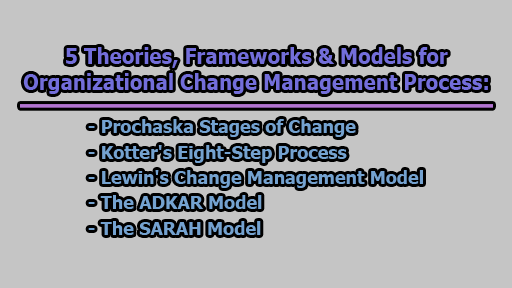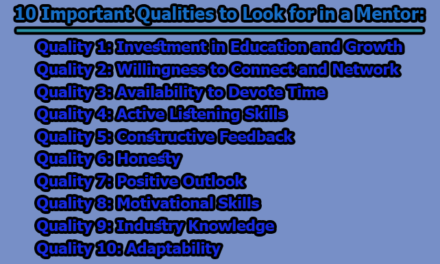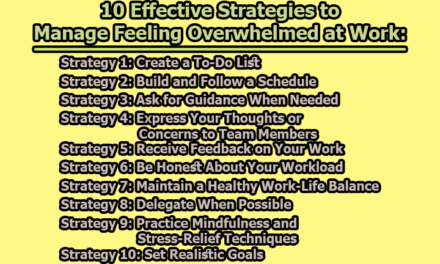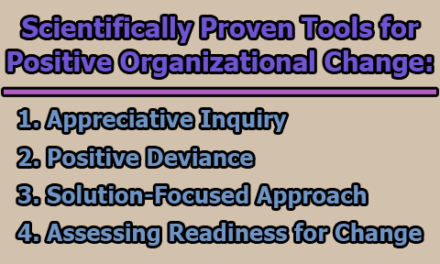5 Theories, Frameworks & Models for Organizational Change Management Process:
Change is an inevitable and essential aspect of organizational growth and development. To effectively navigate through the complex process of change, leaders often rely on various theories, frameworks, and models. Understanding the dynamics and stages of change is crucial for ensuring a smooth transition and fostering positive outcomes. In this article, we will delve into 5 theories, frameworks & models for organizational change management process.
Positive Change Factors:
Before delving into the specific models, it’s essential to recognize the six factors that contribute to positive change, as identified by Dhiman and Marques (2020):
1. Showing up: The first pillar of positive change centers around the concept of “showing up.” This implies instilling trust and confidence in individuals that their presence is not just acknowledged but is vital to the success of the change process. When employees believe that their contributions matter, it creates a sense of belonging and commitment. Leaders play a pivotal role in fostering this trust by recognizing and appreciating the unique skills and perspectives each individual brings to the table.
2. Speaking up: Effective communication is the bedrock of any successful change initiative. “Speaking up” encourages open dialogue, the exchange of ideas, and the voicing of concerns. Leaders must create an environment where employees feel empowered to express their thoughts, ask questions, and offer alternative viewpoints. This not only ensures that all perspectives are considered but also cultivates a culture of transparency and inclusivity, fostering a collaborative atmosphere conducive to positive change.
3. Looking up: Maintaining a higher vision amidst the day-to-day challenges is crucial for steering organizations towards positive change. “Looking up” involves leaders adopting a strategic perspective, focusing on long-term goals, and consistently adding value to the organization’s mission. Leaders should inspire their teams to rise above immediate obstacles and strive for overarching objectives, fostering a culture of resilience and dedication to the greater purpose.
4. Teaming up: Collaboration is a cornerstone of positive change. While individual efforts are valuable, “teaming up” emphasizes the importance of working in partnership. Leaders should encourage cross-functional collaboration, ensuring that diverse skills and expertise are harnessed collectively. Recognizing the significance of both teamwork and individual contributions helps strike a balance that propels the organization forward during periods of change.
5. Never giving up: Persistence and flexibility are the twin engines that drive positive change. “Never giving up” acknowledges the inevitability of challenges and setbacks during the change process. Leaders should instill a sense of perseverance in the face of adversity while maintaining the flexibility to adapt strategies as needed. This resilience ensures that the organization remains agile and responsive, steering through obstacles to achieve successful outcomes.
6. Lifting others up: The final factor, “lifting others up,” underscores the importance of a supportive and celebratory culture. Acknowledging and appreciating the efforts of individuals and teams, sharing credit, and celebrating success creates a positive and motivating atmosphere. This factor not only boosts morale but also reinforces the idea that everyone’s contributions are integral to the organization’s success.
Prochaska Stages of Change:
Prochaska and DiClemente’s transtheoretical model of change offers insights into the stages individuals pass through during the change process:
1. Precontemplation: The initial stage, precontemplation, is characterized by a lack of awareness or acknowledgment of the need for change. Individuals in this stage may be resistant to recognizing existing issues or may be unaware of potential solutions. As leaders, the key focus is on raising awareness among employees, helping them understand the significance of the impending change. Creating a space for open communication and addressing concerns and fears is crucial during this stage.
2. Contemplation: In the contemplation stage, individuals become aware that a problem exists, but they may not yet grasp how the proposed solution could benefit them. Leaders play a crucial role in this phase by articulating the positive impacts of the change, both at the individual and organizational levels. Providing information that helps individuals see the relevance of the change to their personal and professional growth can facilitate a smoother transition to the next stage.
3. Preparation: As individuals move into the preparation stage, they are ready to take the necessary steps toward change. Leaders must provide support during this phase by helping individuals set personal goals and assisting in the planning process. Offering resources, guidance, and encouragement creates a conducive environment for employees to take ownership of their role in the change process.
4. Action: The action stage is marked by individuals actively taking the required steps to implement change. Leaders must provide the necessary support and resources while ensuring that the environment is appropriately structured to facilitate the change process. Communication remains crucial during this stage, reinforcing the vision and goals of the change initiative and addressing any challenges or resistance that may arise.
5. Maintenance: In the maintenance stage, individuals work to sustain their new behavior and maintain a positive outlook. Leaders continue their role by providing ongoing resources, support, and autonomy. It is essential to recognize and celebrate small victories, reinforcing the positive aspects of the change and motivating individuals to persevere. Continuous communication and support contribute to embedding the change as a permanent aspect of the organizational culture.
6. Termination: The final stage, termination, is sometimes viewed as a destination rather than an end state. While not all individuals may reach this stage, it represents a state where the change has become ingrained, and individuals no longer face the risk of relapse into previous behaviors. Leaders should acknowledge and celebrate the successful integration of the change, fostering a culture that embraces continuous improvement and ongoing development.
Kotter’s Eight-Step Process:
John Kotter’s renowned eight-step process provides a structured approach to successful change implementation:
1. Set the Stage: The first step in Kotter’s model involves creating a sense of urgency. Leaders must convey to stakeholders the critical need for change, emphasizing the consequences of maintaining the status quo. This requires a compelling narrative that resonates with employees, encouraging them to recognize the urgency and significance of the impending change. By establishing a shared understanding of the need for change, leaders lay the groundwork for a collective commitment to the transformation process.
2. Create a Guiding Coalition: To successfully drive change, leaders need a powerful guiding coalition. This involves assembling a team of influential individuals across different levels and functions within the organization. This coalition becomes the driving force behind the change initiative, working collaboratively to guide the organization through the transformation. The diversity of perspectives within the coalition ensures a comprehensive approach to problem-solving and decision-making.
3. Develop a Vision and Strategy for Change: A compelling vision serves as the guiding light for organizational change. Leaders, in collaboration with the guiding coalition, must articulate a clear and inspiring vision for the future. This vision outlines the desired state post-change and is accompanied by a strategic plan that delineates the specific steps required to achieve the vision. Communicating the vision effectively ensures that all stakeholders understand the direction and purpose of the change.
4. Communicate the Vision: Communication is central to successful change management. Leaders must consistently and transparently communicate the vision, fostering buy-in and understanding across the organization. This involves addressing concerns, providing updates, and ensuring that employees at all levels feel informed and engaged. Clear communication helps to mitigate resistance and build a sense of shared purpose among employees.
5. Remove Obstacles and Encourage Buy-In: Identifying and eliminating barriers to change is critical during this stage. Leaders must proactively address resistance, whether it stems from organizational structures, processes, or individual attitudes. Encouraging buy-in involves actively involving employees in the change process, seeking their input, and valuing their contributions. By removing obstacles and fostering a culture of collaboration, leaders create an environment conducive to successful change implementation.
6. Create Short-Term Wins: Celebrating early successes is vital for maintaining momentum and building confidence in the change process. Leaders should identify quick wins that demonstrate the positive impact of the change initiative. These victories serve to validate the efforts made so far and inspire confidence among stakeholders, reinforcing the belief that the organization is on the right path.
7. Build on the Change: Rather than resting on early successes, leaders must leverage them to drive further change. Building on the change involves scaling up successful initiatives, reinforcing positive behaviors, and continuously adapting strategies based on feedback and results. This iterative approach ensures that the organization remains agile and responsive throughout the change journey.
8. Make it Stick: The final step in Kotter’s model involves embedding the changes in corporate culture or creating a new culture altogether. Leaders must ensure that the new behaviors, processes, and attitudes become ingrained in the organization’s DNA. This may involve updating policies, aligning performance measures with the change goals, and fostering a culture that embraces continuous improvement and innovation.
Lewin’s Change Management Model:
Kurt Lewin’s three-step process emphasizes the softer, more behavioral aspects of change:
1. Unfreeze: The first stage of Lewin’s model, “Unfreeze,” involves preparing individuals and the organization for the impending changes. During this phase, leaders must create awareness about the need for change and help employees understand why it is essential. Unfreezing involves breaking down existing mindsets and challenging the status quo. This may require leaders to communicate the urgency for change, highlight the inadequacies of current practices, and address any resistance or fear among employees. Unfreezing is about creating a psychological readiness for change by establishing the case for transformation.
Key actions during the Unfreeze stage:
- Communicate the need for change and the reasons behind it.
- Address concerns, fears, and resistance among employees.
- Foster an open and transparent communication culture.
- Build a sense of urgency and commitment to change.
2. Transition: The Transition stage is the heart of the change process, characterized by a shift from the old ways of doing things to the new. This phase often involves periods of uncertainty and confusion as employees grapple with the unfamiliar. Leaders must provide support, guidance, and resources during this stage to help individuals navigate the challenges. Effective communication becomes even more critical to manage expectations, clarify the vision for change, and address any emerging issues. The Transition phase requires careful planning, continuous feedback, and a commitment to flexibility as the organization moves towards the desired state.
Key actions during the Transition stage:
- Provide support and resources to help individuals adapt to change.
- Communicate the vision and goals of the change initiative.
- Address uncertainties and confusion by providing clarity.
- Encourage collaboration and open dialogue.
- Stay flexible and adjust strategies based on feedback.
3. Freeze: The Freeze stage, also referred to as Refreeze, involves stabilizing the new ways of doing things, allowing them to become the new norm. In this phase, the changes are solidified, and employees find a new sense of stability and comfort. The organization establishes new practices, norms, and processes, and individuals begin to embrace the change as part of their daily routine. It is crucial to note that complete stagnation is discouraged, as organizations should remain open to the possibility of further adjustments and improvements.
Key actions during the Freeze stage:
- Reinforce the new behaviors and practices.
- Institutionalize the changes in policies and procedures.
- Celebrate successes and recognize the contributions of individuals.
- Encourage a culture of continuous improvement.
- Monitor and assess the effectiveness of the changes.
The ADKAR Model:
The ADKAR model focuses on five knowledge-sharing goals to ensure change success:
1. Awareness (of the Need for Change): The first step in the ADKAR Model is to create awareness among individuals about the need for change. Leaders must effectively communicate the reasons behind the change, the anticipated benefits, and the consequences of maintaining the status quo. Awareness involves ensuring that employees understand not only the organizational goals but also the personal relevance of the change to their roles and responsibilities.
Key actions during the Awareness stage:
- Communicate the vision and rationale for the change.
- Clearly articulate the potential impact on individuals and the organization.
- Address any misconceptions or concerns proactively.
- Foster an open communication environment.
2. Desire (to Participate in and Support the Change): Once awareness is established, the next step is to cultivate a desire among individuals to actively participate in and support the change. Leaders must translate awareness into a personal commitment, ensuring that employees see the change as an opportunity rather than a threat. This involves addressing any resistance, highlighting the positive outcomes, and fostering a sense of ownership and engagement among individuals.
Key actions during the Desire stage:
- Connect the change to individual and team goals.
- Solicit input and involvement from employees.
- Address and mitigate any resistance.
- Highlight the benefits and positive aspects of the change.
3. Knowledge (of How to Change): Knowledge is central to the ADKAR Model, focusing on equipping individuals with the information and skills necessary to navigate the change successfully. Leaders must provide the training, resources, and support required for individuals to gain a comprehensive understanding of the change process. This involves not only theoretical knowledge but also practical insights into how to implement the change in their day-to-day activities.
Key actions during the Knowledge stage:
- Offer training sessions and resources.
- Clearly outline the steps and processes involved in the change.
- Provide opportunities for hands-on learning.
- Encourage knowledge-sharing and collaboration among employees.
4. Ability (to Change): Building on knowledge, the Ability stage focuses on developing the practical skills and capabilities needed to execute the change. Leaders must ensure that individuals are not only aware of the change and its benefits but also possess the competencies to implement the change effectively. This may involve ongoing coaching, mentoring, and providing real-world opportunities to apply new skills.
Key actions during the Ability stage:
- Provide coaching and support for skill development.
- Offer feedback and guidance on individual performance.
- Create a supportive environment for experimentation and learning.
- Encourage collaboration and knowledge exchange among teams.
5. Reinforcement (to Sustain the Change): The final stage of the ADKAR Model emphasizes the importance of reinforcement to sustain the change over the long term. Leaders must establish mechanisms to reinforce and reward the desired behaviors, ensuring that the change becomes ingrained in the organizational culture. Recognition, feedback, and ongoing support are crucial elements to reinforce the new ways of working.
Key actions during the Reinforcement stage:
- Recognize and celebrate individual and team successes.
- Establish performance metrics aligned with the change goals.
- Provide ongoing support and resources.
- Encourage a culture of continuous improvement and learning.
The SARAH Model:
The SARAH model highlights the stages individuals go through when learning about impending changes:
1. Shock: The initial stage of the SARAH Model is characterized by shock, where individuals may be taken by surprise and may not fully realize the need for change. Shock represents a state of unawareness or disbelief about the impending shifts in the organizational landscape. Leaders must acknowledge this initial reaction and create awareness by clearly communicating the reasons behind the change, the anticipated benefits, and the potential impact on individuals.
Key actions during the Shock stage:
- Communicate transparently about the need for change.
- Provide information on the context and reasons driving the change.
- Address any immediate concerns or questions to alleviate shock.
2. Anger: As awareness sets in, individuals may transition to the Anger stage, where they begin to comprehend the implications of the change. Anger can manifest as frustration, resistance, or a sense of loss. Leaders must be prepared to address and validate these emotions, providing a safe space for individuals to express their concerns. Open communication and empathy are crucial in managing anger effectively.
Key actions during the Anger stage:
- Listen actively to individuals’ concerns and frustrations.
- Acknowledge and validate emotions without judgment.
- Provide forums for open dialogue and expression of grievances.
- Communicate the potential positive outcomes of the change.
3. Rejection: The Rejection stage is characterized by individuals’ resistance to the idea of change. They may prefer to maintain the status quo and resist adapting to new ways of working. Leaders must address this resistance by reinforcing the necessity of the change and emphasizing its positive aspects. Encouraging a sense of involvement and ownership can help individuals move beyond rejection and toward acceptance.
Key actions during the Rejection stage:
- Communicate the benefits and opportunities associated with the change.
- Involve individuals in the decision-making process where possible.
- Highlight success stories from similar changes to inspire confidence.
- Provide additional support and resources for those struggling with acceptance.
4. Acceptance: Acceptance marks a turning point in the emotional journey, where individuals begin to acknowledge and come to terms with the inevitability of change. Leaders should actively support and encourage individuals during this phase by providing resources, training, and guidance. Reinforcing the positive aspects of the change and showcasing early successes can help solidify acceptance.
Key actions during the Acceptance stage:
- Offer training and support to enhance individuals’ skills for the change.
- Celebrate small victories and achievements related to the change.
- Encourage a positive mindset by focusing on the benefits.
- Foster a sense of community and shared purpose among the team.
5. Hope: The final stage of the SARAH Model is characterized by Hope, where individuals recognize the benefits of the change and envision a positive future. Leaders play a crucial role in nurturing and reinforcing this positive outlook. By celebrating achievements, maintaining open communication, and emphasizing the continuous improvement that comes with change, leaders can foster a culture of optimism and hope.
Key actions during the Hope stage:
- Celebrate significant milestones and successes.
- Encourage continuous learning and improvement.
- Recognize and reward individual and team contributions.
- Reinforce a positive organizational culture that embraces change.
In conclusion, navigating organizational change is a complex process, and understanding the various theories, frameworks, and models is crucial for leaders and organizations. By incorporating the insights from the Prochaska stages of change, Kotter’s eight-step process, Lewin’s change management model, the ADKAR model, and the SARAH model, organizations can enhance their adaptability and successfully manage transitions. Each model contributes unique perspectives, emphasizing the importance of communication, collaboration, and sustained effort to achieve lasting positive change. As organizations continue to evolve, embracing these theories and models will empower leaders to navigate change effectively and foster a culture of continuous improvement.
References:
- Abudi, G. (2017). Implementing positive organizational change: A strategic project management approach. J. Ross.
- Dhiman, S., & Marques, J. (2020). New horizons in positive leadership and change: A practical guide for workplace transformation. Springer.
- Kellerman, G. R., & Seligman, M. (2023). Tomorrowmind: Thriving at work with resilience, creativity, and connection, now and in an uncertain future. Nicholas Brealey.
- Lewin, K. (1947). Frontiers in group dynamics. Human Relations, 1, 5–41.
- (n.d.). The ADKAR® change management model. Retrieved January 16, 2024, from https://www.mindtools.com/aou2mjr/the-adkar-change-management-model
- Prochaska, J. O., & DiClemente, C. C. (1982). Transtheoretical therapy: Toward a more integrative model of change. Psychotherapy, 19(3), 276–288.
- (n.d.). The Prosci ADKAR model. Retrieved January 16, 2024, from https://www.prosci.com/methodology/adkar
- Seligman, M. (2011). Flourish: A new understanding of happiness and wellbeing and how to achieve them. Nicholas Brealey.

Former Student at Rajshahi University










